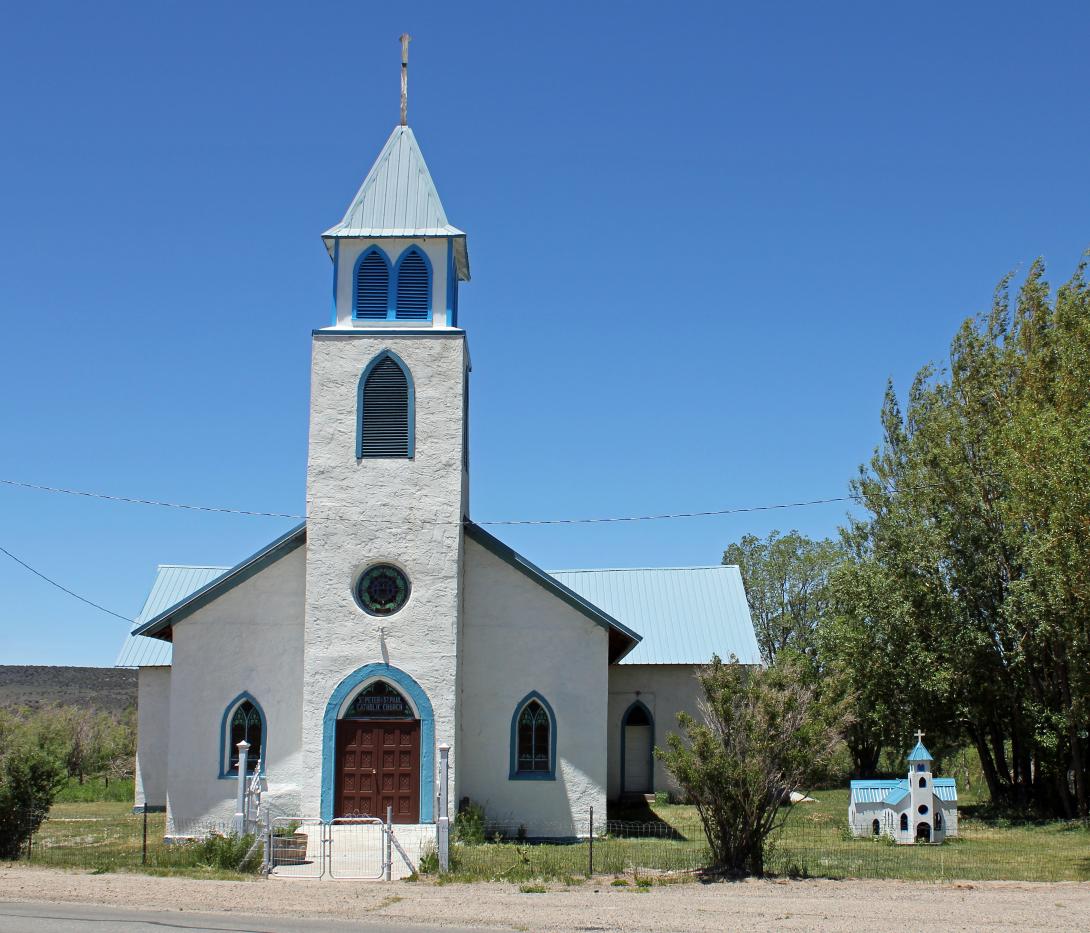Iglesia de San Pedro y San Pablo
Full Article
Located in San Pedro in the San Luis Valley, Iglesia de San Pedro y San Pablo (Church of St. Peter and St. Paul) is a Catholic church built in 1933–34 under the supervision of Father Onofre Martorell. The cruciform-plan Territorial Adobe building continues to serve as an important community center, with Mass celebrated in Spanish during the summer. In 2012 the church was listed on the National Register of Historic Places.
Early Worship in San Pedro and San Pablo
On opposite sides of Culebra Creek in the San Luis Valley, the closely connected communities of San Pedro and San Pablo were among the first towns established by Hispano settlers moving north from New Mexico in the early 1850s. The towns have always collaborated on space for religious worship. As with other early Hispano towns in the San Luis Valley, the towns took their name from the saints that the settlers chose as their spiritual protectors.
The first place of worship in the two villages was a small chapel built south of the present church in 1859, probably a simple chapel made of upright logs plastered with clay. This is the first documented non–native formal religious space in Costilla County, although it is possible that other towns along Culebra Creek had earlier chapels in private homes.
Community members belonging to the lay fraternal group La Sociedad de Nuestro Padre Jesus Nazareno (also known as Los Hermanos Penitentes, the Penitent Brothers) probably helped build the chapel and served the villages’ spiritual needs until Sangre de Cristo Parish was established in the 1880s. The towns were known for a Holy Week reenactment of the Passion of the Christ that was so dramatic that soldiers from Fort Garland supposedly rushed there one year in the 1860s to try to save the man who was supposed to reenact the crucifixion. According to tradition, the community made so much noise at the intrusion that the soldiers’ frightened horses turned and fled back to the fort.
New Buildings
By the early 1890s, the chapel in San Pedro and San Pablo was so badly deteriorated that services were probably being held in a different building. In 1893 a new chapel was constructed in San Pedro. It was a simple building in the Territorial adobe style (made of adobe but with some Anglo design elements, such as a pitched roof), with a dirt floor and no pews. The community donated metal items and melted them down to cast the church bell.
In 1933 a fire destroyed the capilla. The new pastor of Sangre de Cristo Parish, Father Onofre Martorell, oversaw the construction of a new church on the same site. It was the first of many churches that Martorell built or restored during his long tenure as head of Sangre de Cristo Parish, which lasted until 1966. Completed in 1934, Iglesia de San Pedro y San Pablo had a single-story cruciform plan with an eastern nave entrance topped by a tower and wooden cross. Inside, the church had plaster walls, a vaulted ceiling, and a full balcony over the eastern entrance. The tripartite reredos, decorative screens behind the altar, featured statues of Jesus, St. Peter, and St. Paul. Martorell used a similar church design a few years later for the reconstruction of Iglesia de la Inmaculada Concepción in nearby Chama.
In 1941 another fire struck the church. The fire did not destroy the building, but it severely damaged the walls and roof. Local workers Felix and Lucas Serna rebuilt the roof and repaired the walls that summer, shortening the building by ten feet on the east side. Probably at the same time, the exterior adobe walls, which originally had an earthen plaster finish, were covered with cement stucco to protect them from moisture. Single-story additions were built at the northwest and southwest corners of the cross-shaped building to provide more space for storage. The church was rededicated in July 1942.
Today
With its cheery exterior of bright white stucco and blue trim, Iglesia de San Pedro y San Pablo still plays a central role in the local community. During the summer a priest from Sangre de Cristo Parish conducts Mass at each local mission church in the area, including San Pedro y San Pablo. Mass is still conducted in Spanish. In addition, the community gathers at the church during Holy Week before carrying a model of the church to San Luis for religious observances. The community also gathers at the church in January for the Feast of St. Paul and in June for the Feast of St. Peter, when local officials are chosen and money is raised for church maintenance.






























